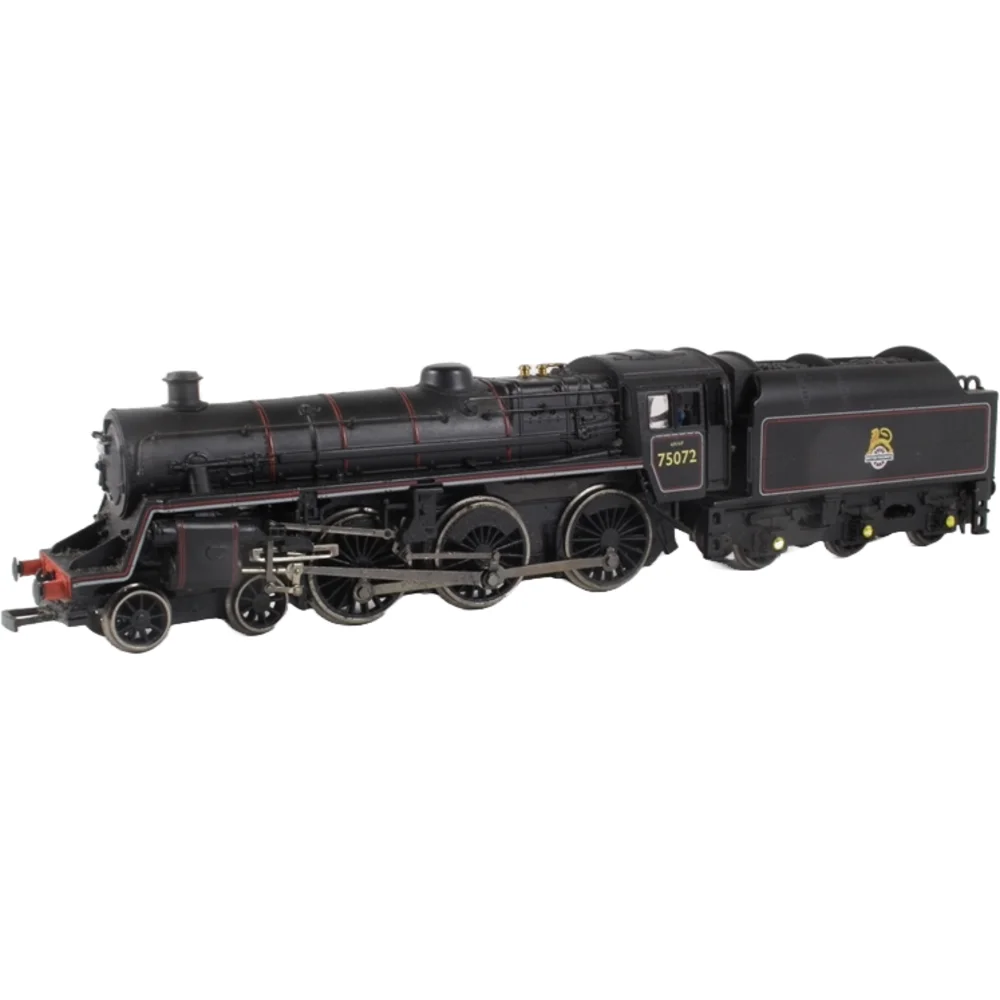Bachmann 31-102A
British Railways Standard 4 4-6-0 75072 British Railways Lined Black with Early Emblem
Tooling
In 1990, Bachmann entered the UK OO gauge market by acquiring the Mainline brand and its tooling. Among the inherited models was the BR Standard Class 4 4-6-0, originally produced by Mainline in the 1980s. This locomotive represented one of the BR Standard designs introduced in the 1950s for mixed-traffic duties. Bachmann’s early releases used the original Mainline tooling with minimal changes, marking the start of Bachmann’s presence in British outline models.
Tooling Features
- Scale: OO gauge (1:76.2), designed for 16.5mm track.
- Construction: Plastic body shell with separately fitted details typical of Mainline tooling; tender and locomotive bodies were finely moulded for the era.
- Detailing: Good for its time, including handrails, smokebox door detail, and rivet representation. Cab detail was basic and largely moulded.
- Couplings: Standard tension-lock couplers mounted on the tender and locomotive.
Mechanical & Electrical
- Motor & Drive: Split-chassis design with a centrally mounted motor driving the coupled wheels via gears. Electrical pickup was through the chassis halves.
- Minimum Radius: Recommended for second radius curves (approx. 438mm).
- Lighting: No factory lighting provided.
- Weighting: Moderate weight; relied on diecast chassis components for traction.
DCC Capability
The 1990 tooling was not DCC-ready. Conversion required hardwiring a decoder and insulating the split chassis, which was considered challenging for beginners.
Liveries Produced
Early Bachmann releases using this tooling were offered in British Railways lined black and lined green liveries, reflecting the prototype’s mixed-traffic role. Variants included different running numbers and tender types.
Reviews & Commentary
At launch, the model was praised for its accurate proportions and fine body detail compared to contemporary Hornby offerings. However, the split-chassis mechanism attracted criticism over time for reliability issues, electrical pickup problems, and difficulty in servicing. Enthusiasts often noted that while visually appealing, performance could be inconsistent without careful maintenance.
Media & Social Media
Collectors and modellers frequently discuss these early Bachmann models on forums and social platforms, often highlighting their historical significance as part of Bachmann’s UK debut. Videos and guides on servicing the split-chassis mechanism remain popular resources for those restoring these locomotives.
Interesting Notes
- The tooling originated from Mainline’s design, which was considered advanced in the 1980s for its level of detail.
- These models are now regarded as collectible, especially boxed examples in original Bachmann packaging.
Class & Prototype
- Class: British Railways Standard 4 4-6-0
- Traction: Steam
- Built: 1951-1957
- Total Built: 80
- Running Number: 75072
- Name: -
- Ordered By: British Railways
- Built By: British Railways
- Built At: Swindon
- Built: 11/1955
- Withdrawn: 12/1965
- Length of Service: 10.1 years
- Running Numbers: BR 75072
- Names: -
Operator & Livery
- Operator: British Railways
- Livery: Lined Black with Early Emblem
British Railways transformed Britain's fragmented rail network into a unified national system following nationalisation on 1st January 1948. Created from the "Big Four" companies under the Transport Act 1947, BR operated most of Great Britain's railways until rebranding as British Rail in 1965, managing over 20,000 route miles and inheriting nearly 20,000 locomotives of diverse designs.
The organisation pioneered standardisation through its revolutionary BR Standard locomotive programme (1951-1960), producing 999 advanced steam engines under Robert Riddles' direction. These included the versatile Britannia Pacifics, mighty 9F freight engines, and mixed-traffic classes that incorporated the best features from all predecessor companies. The 1955 Modernisation Plan accelerated diesel and electric traction development, creating fascinating mixed-traction operations.
Notable achievements included establishing unified locomotive classification systems, introducing distinctive corporate liveries, and managing the complex transition from steam to modern traction. BR's six regional structure preserved operational diversity whilst enabling standardisation of practices, signalling, and rolling stock that had eluded private enterprise for over a century.
The BR era represents steam traction's final flowering alongside emerging diesel technology, creating unparalleled locomotive variety. Today, this heritage remains highly popular with railway enthusiasts through extensive preserved fleets, heritage railway operations, and comprehensive model ranges from manufacturers like Hornby, Bachmann, and Dapol, making BR subjects essential for authentic post-war British railway modelling across all scales.
British Railways' lined black livery was designated for mixed-traffic and secondary passenger locomotives from 1949, following pure LNWR style with black base colour and elaborate red, cream (off-white), and grey lining patterns. The lining specification comprised 5/8" grey, 1/8" cream, 1½" black, and ¼" red bands, with the layout consistent with LNWR practice including deep and shallow valances lined along bottom edges only, unlike green engines. The first lined black engines appeared in August 1948 when Hall 5954 appeared so painted, becoming one of the first to carry the "Lion and Wheel" emblem around the same time.
A wide range of engines was eligible for this livery, from powerful V2s and Counties down to tiny Southern Terriers, encompassing County, Hall, Grange, Manor, Saint, Prairie tanks, and numerous pre-grouping designs of varied shapes and sizes. This created many variations and interpretation problems due to the diverse locomotive types involved, with regional differences in splasher lining treatment—the Eastern Region used red-only splasher lining, whilst the Southern Region evolved from inset to edge lining styles. The emblem was positioned centrally on tender sides above the middle axle box, with the Western Region favouring larger sizes on tenders and bigger tank engines. An interesting period detail saw number plates routinely painted red from late 1949 to early 1952, adding colour contrast to the otherwise black scheme. This livery represented BR's commitment to standardising mixed-traffic operations whilst maintaining the decorative traditions that distinguished passenger-rated locomotives from plain freight engines.
